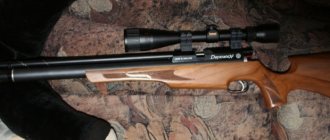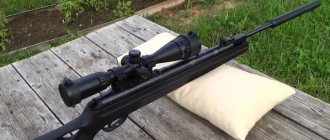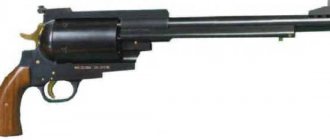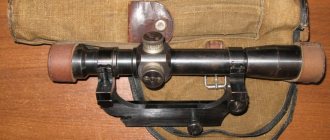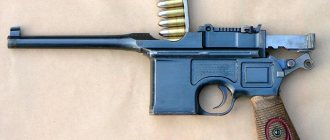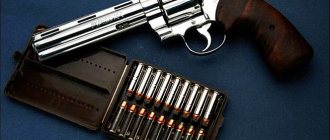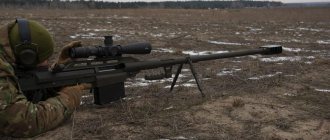People interested in military culture or weapons probably know about the existence of such a rifle as the three-ruler. However, if in the case of the Kalashnikov assault rifle, everyone has long known why and in honor of whom the truly classic and legendary weapon received its name, then not everyone knows why the three-ruler is so called. But today we will look into this issue.
The need to create a new type of small arms
The geopolitical situation was tense. Germany, Austria-Hungary and Italy formed an alliance against Russia and France (the Triple Alliance). Russia was fighting with Britain for influence in Asia.
By the end of the eighties of the 19th century, Western countries re-equipped their armies with rifles with a middle magazine. The weapon was loaded with inventory cartridges, using smokeless powder and jacketed bullets.
The Russian army was armed with a single-shot Berdan rifle. After each shot, the soldier had to insert another cartridge manually. The Berdanka's rate of fire was low. It was fired with a 4.2 line caliber cartridge containing black powder. In the early 80s of the 19th century, the spread of smokeless gunpowder had already begun in Europe.
Its appearance significantly accelerated the development of small arms. Smokeless powder is three times more powerful than smoked powder. Its use made it possible to reduce the size of the cartridge and its weight. The weapons also became lighter. In addition, smokeless shooting does not reveal the location of the shooter, which is especially important for the work of snipers.
Development of a three-line rifle
In 1889, a competition was announced to develop a new infantry weapon chambered for a three-line cartridge. One of its participants was Russian army captain Sergei Ivanovich Mosin.
Domestic and foreign designers got involved in the work. Among them is the Belgian Leon Nagant. The tests revealed a slight advantage of the Belgian weapons.
In no way inferior to its competitor in terms of combat characteristics, the Russian rifle more often caused delays when firing. However, the commission noted that the Russian officer’s product is distinguished by its remarkable simplicity of design. Its production will cost the treasury much less.
After eliminating the comments, it will not be inferior to the Belgian model. The redesigned rifle had parts developed personally by Mosin, proposed by members of the commission, and a clip design from Nagant. That is why the commission gave the product the name: “three-line rifle of the 1891 model”, without the name of the inventor.
This is interesting: abroad the three-line rifle is called the Mosin/Nagant rifle. The design of the cartridge clip and the slot in the bolt for its installation was borrowed from Nagant.
These “borrowings” do not in any way affect the combat capabilities of the weapon. However, for his “contribution” Nagan received a bonus of 200,000 rubles in gold from the Russian government. Now this amount is equivalent to 10 million dollars.
The original name and history of the development of the “Mosin Rifle”
It is important to understand that the name “Three Line” is a common one, and this rifle has an original, official name. It sounds like a “Mosin rifle.”
This weapon was developed over 100 years ago, and its production dates back to 1892. Despite the ownership of these weapons by the Russian side, factories in France were also involved in the production of rifles, since the lack of production capacity of domestic factories made it impossible to fulfill the minimum order.
After their creation, the rifles were quickly adopted by the Russian army, and were widely used for more than half a century, starting in 1881 and ending in the late 1950s.
We will look at the question of why the Mosin rifle is called a three-line rifle a little lower, but now we need to pay attention to the origin of the original name.
The fact is that Mosin S.I. was a designer and organizer of weapons production, in addition, he also held the rank of major general in the Russian army. During his life, Mosin was involved in the development of repeating rifles and the improvement of other weapons used by the Russian army. It was precisely such merits that led to the fact that the rifle was named in his honor.
Biography of S.I. Mosin
The three-line rifle helped its creator find happiness in his personal life. In 1875, Captain Mosin was sent to Tula to serve at a weapons factory. There he met his love, Varvara Nikolaevna Arsenyeva.
She was a married woman, the mother of two sons. Her husband paid little attention to the family, spending his time in both capitals. The young people confessed their mutual feelings to each other. The explanation between Mosin and Arsenyev almost ended in a duel. The captain sent a challenge to the landowner.
Arsenyev complained to the military authorities. The officer in love was placed under house arrest for three days. A repeated summons in front of witnesses in the noble assembly ended in two weeks of arrest. Four years later, in response to Mosin’s request to divorce his wife, Arsenyev demanded 50,000 rubles in payment for the “service”. The captain got this money only eight years later, thanks to the creation of a three-line rifle. In 1891, 16 years after they met, the couple in love became a family.
Characteristic
Tactical and technical characteristics (TTX) of the Mosin rifle
| Cartridge | 7.62x54 mm |
| Weight with full equipment | 4.5 kg |
| Length | 130.6 cm |
| Magazine capacity | 5 rounds |
| Sighting range | 2200 m |
The numbers 7.62x54 indicate, respectively, its caliber and the length of the cartridge case in millimeters. This cartridge has been around for over a hundred years. At the beginning of the 20th century it was used in a three-line rifle and a Maxim machine gun. Later, various weapons were created for this cartridge: automatic rifles, light machine guns, and heavy machine guns.
Initially, separate rifles were developed for infantry, dragoons and Cossacks (cavalry). They were distinguished by the length of the barrels, and the Cossack one was produced without a bayonet. In 1907, production of three-line carbines began, which were used to arm artillerymen, signalmen, and sappers.
These specialists required short weapons that would not interfere with their primary duties. The bayonets of the rifles and carbine were faceted, sharpened like a screwdriver. They were used when disassembling weapons.
This is interesting. All rifles of that time were sighted only with a bayonet. Shooting without a bayonet resulted in a serious deviation of the bullet from the aiming point. When shooting at long distances, shooting accuracy decreased significantly. Therefore, before the battle, the bayonet had to be attached.
Why is the rifle called “Three Line”
As for the common name, which was very quickly assigned to the Mosin rifle, it sounds like “Three-line”. And this name has a completely rational explanation, because it comes directly from the caliber that was assigned to the Mosin rifle. During the years of use of this weapon, weapon caliber was measured using an outdated length measure using "Lines". Then the lines were equal to 2.54 mm. (1/10 inch).
Based on the information presented above, it is easy to draw a parallel and understand that the caliber of the Mosin rifle had three lines, that is, 3/10 of an inch or 7.62 mm. This is why the Mosin rifle is called the “Three Line” to this day, and its second name has become almost more popular than the original one, received in honor of Mosin himself.
Class! 31
Weapons of all wars and revolutions
By 1914, the Russian army received more than 4.5 million three-line rifles of all variants, including the carbine. During the fighting, the army received another 3.2 million guns. Despite this, the front lacked weapons.
Many rifles went to the Germans and Austrians as trophies. The government ordered one and a half million three-rulers from the USA. Part of this order did not reach Russia. The revolution has begun.
In 1930, the bayonet mount was changed and the manufacturing technology was simplified. The modified product receives the official name “Mosin rifle of the 1891/30 model.” In 1932, the industry launched the production of a sniper rifle. In 1938, the SVT 38 (Tokarev 38 g self-loading rifle) began to enter the troops.
They were going to make it the main weapon of the Red Army and displace the three-line gun no later than 1940. By 1941, the army received more than a million Tokarev self-loading guns. However, the outbreak of war prevented the completion of arming the army with automatic rifles.
The production of the SVT was much more complicated and more expensive than the three-line gun and the submachine gun. Therefore, the production of Tokarev’s product was sharply reduced. The main weapon of the rifle regiments was still the mosquito. In 1944, the Mosin '38 carbine underwent another modernization. When he began joining the army, rifle production ceased.
Combat experience has shown the advantages of shortened weapons in cramped conditions of trenches, street battles, and wooded areas. Infantry armed with carbines became more mobile. The combat capabilities of the carbine were practically not inferior to the rifle. This weapon remained in service until it was replaced by a Kalashnikov assault rifle.
The Finnish army actively used Mosin three-line guns in battles with the Red Army. The Finns inherited a large supply of these weapons after the revolution. During the Soviet-Finnish conflict in the winter of 1939-40, these reserves were replenished with trophies. The rifles were constantly being improved. The trunks were ordered abroad, the stock was carved from Karelian birch. Knife bayonets. One modification had the shape of a Finnish knife. Finnish three-line models had the names M 91-24, M-28; M-28-30, M-38.
In 1959, the Izhevsk plant converted the rifles remaining in the warehouses into carbines, with the subsequent arming of private security fighters. Abroad they are called 1891/59. The armies of many countries around the world were armed with the three-line weapon. She became a participant in most wars and armed conflicts, including our time.
Description of the Mosin rifle "Three Lines"
Review article about the PU sightReview article about the PE sightReview article about the Mosin sniper rifle Photo of the sawn-off shotgun of the Mosin “Kulak sawn-off shotgun” rifle
Mosin rifle 1891/30 - also known as “Mosinka”, “Russian 3-line”, “Three-line” . A non-automatic rifle with a non-removable magazine feed for 5 rounds of 7.62x54 mm, adopted by the Imperial Russian Army in 1891. The official name is “ 7.62 mm Mosin rifle mod. 1891 " received in 1924. “ three-ruler ” rifle was nicknamed for the caliber of the barrel; previously, calibers were measured using lines. One line was equal to one tenth of an inch (1 inch equals 2.54 cm), hence 2.54 x 3 = 7.62 mm.
The Mosin rifle was not the first magazine-fed rifle. So in the USA, during the Civil War in the 19th century and military operations against the Indians, Spencer rifles with a magazine located in the butt were used. The Henry rifle had an under-barrel magazine. In 1877-1878, during the Russian-Turkish War, a Russian soldier had to experience the hard way of the advantage of multi-shot rifles with a rifled barrel. These rifles were Winchester rifles with under-barrel magazines.
Rifles of that time with under-barrel or butt-mounted magazines had a number of disadvantages. As a rule, they used insufficiently powerful pistol cartridges with a blunt bullet; to increase safety, they had to use cartridges with rim-ignition powder, since cartridges with a centrally located cartridge led to the cartridge being fired in front of the cartridge during operation. Rimfire cartridges often misfired. Firing pistol cartridges was significantly inferior to the efficiency of shooting rifle cartridges. So the pistol cartridge could not penetrate many types of fortifications, did not have sufficient accuracy, and had a short sighting range. The problem with rifles of that time was still the price, since in the 19th century there were no weapons factories that could produce firearms in an assembly line manner, for this reason magazine-fed rifles were quite rare and expensive. Like all first-generation models, they had problems with reliability and maintenance.
In 1879, James Paris Lee patented the in-line store layout. The first rifle with a safe in-line arrangement of cartridges in the magazine was the Mannlicher rifle of the 1886 model. In 1889, they solved the problem of quickly loading rifles with in-line cartridges using special clips. The clips significantly speeded up the reloading of weapons during combat, which increased the weapon's combat rate of fire. In Tsarist Russia in 1882, the Main Artillery Directorate gave instructions for the development of a multi-shot rifle. In 1883, the definition of “rifle” appeared in Russia; previously, any long-barreled hand weapon was called “gun,” that is, there was no difference between smooth-bore and rifled weapons. The first rifles for the Tsarist Army wanted to be chambered for the 4.2-line cartridge. More than 150 domestic and foreign rifles were reviewed. During the competition, the good performance characteristics of the S.I. Mosin rifle of the 1887 model were noted, but nevertheless it was decided to abandon it, since it was magazine-fed. The disadvantage of such loading was described above in the article. Also in Russia, rifles with a smaller caliber (7-8 mm) began to be tested. So in 1885, Colonel Rogovtsev created a 3.15-linear (8 mm) cartridge using “Beradnovsky” cartridges as a basis. Rogovtsev’s cartridges were distinguished by an increased content of nitrate and bullets with copper jackets, which significantly increased the life of the barrels and compression when fired, and the 13.6 gram bullet accelerated to 550 meters, which gave the cartridge a force of 2057 J.
Military masters of repeating rifles in Tsarist Russia were faced with the conservative views of the military, who began to argue that there was no need for such rifles, that such rifles needed a lot of “gluttonous” ammunition. There was no war with the massive use of repeating rifles. They also understood that re-equipping with a new rifle would require a lot of financial resources. In addition to conservatism, the appearance of new rifles and the rapid obsolescence of rifles, which a couple of years ago were considered as the main rifle for the Tsarist Army, played a factor. At the same time, a revolution occurred in ammunition, when black powder was replaced by smokeless gunpowder, which significantly increased the performance characteristics of weapons. In 1888, the Tsarist Army received Austrian 8-mm Mannlicher rifles and Danish Krag Jorgensen rifles. During testing, it turned out that the rifles had good accuracy, but low bullet speed (508-530 m/s), since black powder was used for firing. Also, the shutter mechanisms did not meet the requirements. In 1889, the famous chemist Dmitry Ivanovich Mendeleev had a hand in creating domestic smokeless gunpowder. In the same year N.F. Rogovev created a 3-line cartridge with a cupronickel silver bullet; a high-quality capsule for cartridges was made only in 1890. At the same time, it was decided to adopt cartridges with a rim at the bottom of the cartridge case. At this stage of development, the 3-linear cartridge was not fully adopted, so a 6.5 mm cartridge would soon be developed.
In 1889 S.I. Mosin presented his 7.62 mm rifle with a stack-loading magazine, like the Austro-Hungarian Mannlicher rifle, but it required improvement. At the end of the same year, the Belgian Leon Nagant (yes, the same designer of the Nagant revolver) presented to the military commission 3 variants of 8 mm repeating rifles. Leon Nagant rifles were well appreciated for their successful magazine design and the ability to load with a clip, but shortcomings were noted that required improvement. In 1890, the Nagant rifle received 14 positive votes against 10 negative votes at the first introductory competition. In essence, the Nagant and Mosin rifles were structurally similar, but the Nagant rifle had an advantage in the quality of finishing, as it was manufactured on high-quality machines, unlike the Mosin prototype. But at the second stage of field testing, when 300 Mosin rifles and 300 Nagant rifles were tested, the Mosin rifles turned out to be more reliable: 217 cartridges were delayed from the magazine, versus 557 for the Nagant rifles. In 1891, the commission decided to choose the Mosin rifle , since the production of rifles was planned in Russia (technical independence), and not abroad, plus it significantly saved budget money. The commission gave instructions for refining the rifle and then putting it into service. To modify the Mosin rifle, it was recommended to take a clip for charging, a spring for the magazine and a reflector for spent cartridges. So to some extent it was fair to call the rifle Mosin-Nagant. But they abandoned the name Nagan by renaming it “Russian 3-line rifle of the 1891 model.” On April 16, 1891, Emperor Alexander III decided to remove the “Russian” from the name and adopted it for service as a “three-line rifle of the 1981 model.” For the development of the rifle, Mosin was awarded the Grand Mikhailov Prize. In 1924, the Soviet government decided to add Mosin's surname to the name of the rifle, as a tradition of naming weapons in honor of the main designers. Although in foreign sources on weapons topics, the names of the main weapon designers are often written: the Mosin-Nagant rifle, the Tokarev-Colt pistol, the Makarov-Walter pistol, etc.
During the Russian Civil War of 1917-1923 and in criminal circles, the Mosin rifle was “cut off” and a kind of pistol chambered for a rifle cartridge was obtained. Often such a sawn-off shotgun was called a “kulak sawn-off shotgun.” View photo with cropped shot.
In 1892, the Mosin rifle began to be produced at three arms factories at once: Sestroretsk, Izhevsk, and Tula. Since the production capacity of these factories was not enough. To speed up the armament of the army, Tsarist Russia decided to place an order for 0.5 million rifles in France at the plant in the city of Chatellerault. The following year, the Mosin rifle was used for its intended purpose for the first time in the Pamirs against the Afghans. As the Mosin rifle , modifications began to be made to it. In 1893, to protect the hands of soldiers from burns to the barrel, they began to put a wooden cover on it. In 1896, the rifle began to be equipped with a longer cleaning rod, with a head larger than the diameter of the barrel, so that it would not fall into the barrel. Then they removed the notches on the sides of the magazine so that they would not rub off the soldiers’ uniforms. By the end of 1897, the Russian army received more than 500 rifles, thereby completing the first stage of rearmament. Before the start of the Russo-Japanese War of 1904-1905, 3.8 million “three-line” rifles were manufactured for the Tsarist Army. In 1908, cartridges with a pointed bullet began to be used for rifle shooting; before that, the bullet had an oval head, like pistol cartridges. With the advent of the new cartridge, Konovalov sights with ballistics for the new cartridge began to be installed on rifles. The new cartridge weighed 22.55 grams - bullet weight 9.7 grams, had an initial speed of 850 m/s from a Cossack rifle and 880 m/s. three-rulers were delivered to the Tsarist Army . During WWII, another 3.3 million rifles were manufactured for the army. The Mosin rifle was manufactured in four versions: dragoon, infantry, Cossack, and carbine. Even with this number of rifles, the army continued to experience a shortage of rifles and the government purchased various variants of rifles from other countries. During the Russian Civil War, only infantry and dragoon versions of the rifle were produced. After 1922, a dragoon version and a carbine of the 1907 model were produced.
After WWI and the Civil War, the Soviet government decided to modernize the Mosin rifle or abandon it due to the rapid obsolescence of repeating rifles and the desire to arm the army with self-loading rifles. In 1924, the military commission decided to modernize the dragoon version of the rifle as a more convenient option. The new rifle received the GAU index -56-B-222. The rifle began to be widely used at OSOAVIAKHIM for training shooting for the “Voroshilov shooters”. In 1928, Soviet industry mastered its own production of optical sights for Mosin rifles: , . In 1923, military factories began to produce a sniper version of the Mosin rifle (index GAU-56-V-222A). The sniper version was distinguished by improved barrel quality, selection of barrels with better accuracy, and a bolt handle curved down, since the optical sight did not allow the use of the classic bolt version, for this reason the Mosin sniper rifle was loaded one cartridge at a time. The quality of the barrel, which had a check, was different. 108,345 Mosin sniper rifles were produced. Let's move a little away from the topic, but 120,000 PE sights were manufactured, 500,000 PU sights. the Mosin carbine was adopted , which was 1905 Mosin carbine As a rule, such a carbine was armed with fighters who needed a compact and lightweight self-defense weapon: cavalry, signal troops, artillerymen, sappers.
In 1938, the Tokarev-SVT Self-Loading Rifle was adopted by the Red Army, which was supposed to replace the Mosin rifle . The military departments planned to supply 1.8 million SVT rifles to the army in 1941, and 2 million SVT rifles in 1942; in fact, by the beginning of the war, about 1 million SVT rifles were manufactured. But during the war, the Mosin rifle became the small arms of the Red Army fighters, so the factories could not quickly produce more complex automatic weapons in large quantities (machine guns, automatic rifles, submachine guns). The Mosin rifle for half of the small arms that participated during the Second World War. Production of the Mosin rifle was discontinued at the beginning of 1945, when the outcome of the war was decided, and there were enough weapons accumulated in warehouses. The Mosin carbine of the 1944 model was produced until 1949. The last modernization of the Mosin rifle took place in 1944: the bayonet was made folding.
Automation
The rifle barrel has 4 grooves. The distance between the grooves ranges from 7.62 to 7.66 mm. The magazine has a springy bottom and holds 5 cartridges in one row, so that one cartridge runs over the edge of the bottom onto the body of the previous cartridge, so that the edges do not overlap. One cartridge was immediately fed into the chamber when the bolt was closed. The rifle could be unloaded by jerking the bolt or opening the bottom of the magazine. When the bolt moved back, the striker spring was cocked; when the bolt moved forward, the cartridge was captured and fed into the chamber. After the shot, the cartridge case was pulled out and flew to the side with the help of a spring reflector. The trigger assembly consists of a trigger, which releases the movement of the combat cylinder, which is pushed by a spring. The trigger travel is quite tight and the shot occurs without conscious warning. The stock stock was made of birch or walnut wood. The cartridges in the magazine are cut off using a reflector, one cartridge at a time. The Mosin rifle has an open sight rail in steps (arshins) on rifles produced before 1930, later replaced by a sight in meters with an aiming range of 2000 meters in 50 meter increments made under Soviet rule. A sighting bar at 2000 meters does not imply shooting at such a distance, since a person at 800-1000 meters is not able to see a human figure against the background of buildings or bushes. A bayonet is one of the “ three-line ” elements that was used for use during hand-to-hand combat. Also, the bayonet had to always be attached to the rifle during shooting, and its removal was only provided for on the march or when moving in transport. The use and sighting of the rifle always had to take place with an attached bayonet; in its absence, the aiming line shifted significantly and at long distances it became difficult to hit the target. The Mosin rifle has excellent accuracy for a weapon that was mass produced. So at a distance of 100 meters the deviation is no more than 3 cm (SVD-10 cm rifle), at 1000 meters - 33 cm, and at 2000 meters - 170 meters.
Advantages of the Mosin rifle:
- Price and own production
- Penetration ability of cartridges
- Long barrel resource
- Reliability and reliability in any climatic conditions
- Excellent accuracy at different distances
- Durable stock and stock
- Fast charging using a clip
- Quick Release Shutter
- Removable bolt cylinder, which can be replaced separately without replacing the bolt
- Didn’t spoil the cartridge when feeding it into the barrel
Disadvantages of the Mosin rifle:
- An outdated cartridge with a rim, although a very controversial point, since the cartridge is widely used even now and there are no plans to abandon it
- An obsolete bayonet that was supposed to be fixed during shooting. The second point is that with a fixed bayonet, a fighter greatly lost mobility while moving through the trenches or fighting in urban conditions.
- Low rate of fire
- Lack of standard space for a bracket for an optical sight
- Lack of muzzle brake-compensator
- The magazine holds only 5 rounds; it could be increased to 10 rounds or upgraded to use magazines of various capacities.
The sheer number of Mosin rifles , 37 million, speaks volumes about its popularity and reliability. The rifle is/was in service with many countries around the world, and is/was produced by several countries. on the basis of the Mosin rifle . In the post-war years, 32-caliber smoothbore shotguns, nicknamed “Frolovkas,” began to be made from rifles. Also based on the Mosin rifle, sporting versions chambered for the 6.5 mm cartridge were made.
PS MMG Mosin rifles in the Russian Federation cost 35,000 rubles, and a combat rifle purchased at military warehouses of the Russian Federation and traveling 10,000 km to a weapons store in the USA costs 7,000 rubles ($120), or even cheaper.
Performance characteristics of the Mosin Sniper Rifle
| Number of shots | 5 |
| Barrel caliber | 7.62x54 R |
| Combat rate of fire | 10-14 rounds per minute |
| Maximum rate of fire | 55 rounds per minute |
| Sighting range | 2000 meters |
| Maximum firing range | 3500 meters |
| Effective shooting | 600-800 meters |
| Initial departure speed | 870 m/s |
| Automation | sliding bolt locking |
| Weight | 4.5 kg, sight PE-0.6 kg, sight PU-0.3 kg |
| Bullet energy | 2600-4150 J |
| Dimensions | infantry - 1500 mm, dragoon - 1300 mm |
Three-ruler in civilian life
Three-line variants called KO-38 and KO-44 were produced as civilian (conversion) weapons in the Soviet Union. From the name it is not difficult to guess that the basis of this weapon are carbines of the 38 and 44 model. They look like military weapons. What distinguishes them from the military version is the absence of a bayonet and the presence of a mark-forming pin in the barrel (a requirement of criminologists).
Hunting rifles KO-8.2 and KO 91/30, converted from combat samples, KO-8.2 uses an 8.2 mm caliber cartridge. The sighting range has decreased significantly. But the stopping power of the ammunition has increased, which is especially important when hunting large animals: elk, bear and wild boar.
Three-line guns sell well in the markets of many countries around the world as civilian weapons. Reasonable price and excellent characteristics make them popular among hunters and collectors. In 2012, rifles of the 91/30 model took first place in the list of weapons sold to the public in the United States. Their approximate price fluctuates around $100.
